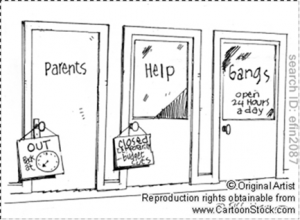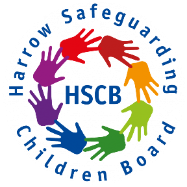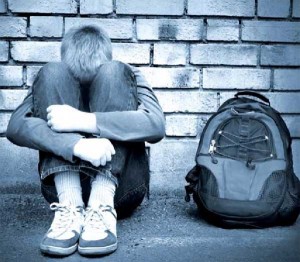Gangs – Guidance
There are a number of areas in which young people are put at risk by gang activity, both through participation in and as victims of gang violence which can be in relation to their peers or to a gang-involved adult in their household.
A child who is affected by gang activity or serious youth violence may have suffered, or may be likely to suffer, significant harm through physical, sexual and emotional abuse
Significant harm is a situation where a child is suffering, or is likely to suffer, a degree of physical, sexual and / or emotional harm (through abuse or neglect), which is so harmful that there needs to be compulsory intervention by child protection services
Groups of children often gather together in public places to socialise, and peer association is an essential feature of most children’s transition to adulthood. Groups of children can be disorderly and/or anti-social without engaging in criminal activity.Defining a gang is difficult, however it can be broadly described as a relatively durable, predominantly street-based group of children who see themselves (and are seen by others) as a discernible group for whom crime and violence is integral to the group’s identity.Children may be involved in more than one ‘gang’, with some cross-border movement, and may not stay in a ‘gang’ for significant periods of time. Children rarely use the term ‘gang’, instead they used terms such as ‘family’, ‘breddrin’, ‘crews’, ‘cuz’ (cousins), ‘my boys’ or simply ‘the people I grew up with’.Definitions may need to be highly specific to particular areas or neighbourhoods if they are to be useful. Furthermore, professionals should not seek to apply this or any other definition of a gang too rigorously; if a child or others think s/he is involved with or affected by ‘a gang’, then a professional should act accordingly.Violence is a way for gang members to gain recognition and respect by asserting their power and authority in the street, with a large proportion of street crime perpetrated against members of other gangs or the relatives of gang members.Youth violence, serious or otherwise, may be a function of gang activity. However, it could equally represent the behaviour of a child acting individually in response to his or her particular history and circumstances.The Metropolitan Police Service defines serious youth violence as is ‘any offence of most serious violence or weapon enabled crime, where the victim is aged 1-19’ i.e. murder, manslaughter, rape, wounding with intent and causing grievous bodily harm. ‘Youth violence’ is defined in the same way, but also includes assault with injury offences. The factors which influence a child’s propensity to initiate violence include:
- Parenting which is cold / uncaring, non-nurturing and neglectful;
- Parenting which includes harsh disciplining;
- Maltreatment, such as physical or sexual abuse in childhood (abuse by adults and peers within and outside of the family); and/or
- Trauma such as domestic violence or involvement in or witnessing conflict violence (see also domestic and sexual violence).
One factor which influences a child’s propensity to imitate violence is:
- Parenting which is permissive and neglectful, resulting in a lack of guidance and creating ineffectiveness and poor self-control for a child. The child is then not equipped to resist an environment or group which instigates violence.
Find out more about; community and family circumstances, professional response, agency response and violent extremism here.
What is it about: The Exit Path Gang Prevention and Support Program offers 1-2-1 preventative or intervention support to children and young people at risk of gang-related behaviour and/or involvement in serious youth violence including the possession or carrying of offensive weapons such as a knife.
Prior to submitting a referral, referrers are encouraged to read and use the below thresholds
(1) Getting into fights and considering carrying weapons such a knife for personal safety,
(2) Performing poorly at school and is at risk of permanent exclusion as a result of involvement with negative peers or gangs,
(3) Goes missing for sometimes with risks of becoming involved in county line and drug supply activities,
(4) Has extra money and explains it with stories you have trouble believing, including purchased branded items e.g. clothings, trainers or phones,
(5) Has befriended peer groups affiliated to gangs,
(6) Is known to consume and/or sell illegal substances on behalf of a gang or a gang member,
(7) Has a tendency to resort to anger, aggression and violence to resolve disputes,
(8) Has been victimised by individuals or groups linked to gangs
Who is the target: The program is targeted at children and young people, aged 13 to 17, who are at risk of gang affiliation, victimisation, criminalisation and/or involvement in serious youth violence.
Delivery arrangements: Upon receipt of a referral and consent from parents, carers or guardians, the program co-ordinator will complete a pre-screening assessment to contextualise the needs, risks and vulnerabilities of a young person being referred. 1-2-1 preventative or intervention support sessions aim to inform, challenge and have a positive impact on a young persons outlook, attitude and behaviour. All delivered sessions are governed by use of themed worksheets, visual and audio materials.
Referral Process: To submit a referral please complete a referral form and send it to Duty&Assess@harrow.gov.uk or Duty&Assess@harrow.gov.uk.cjsm.net.
The Children’s Society has produced a toolkit for professionals which deals with the issue of children and young people trafficked for the purpose of criminal exploitation in relation to county lines.
The term county lines is becoming widely recognised and used to describe situations where children or young people may be internally trafficked for the purpose of criminal exploitation. What is often less understood are the experiences a child or young person faces, and the potential for them to be harmed through various forms of abuse and exploitation as a result. This toolkit hopes to address some gaps in knowledge and offer suggestions for supporting young people who are being, or at risk of being, trafficked for the purpose of criminal exploitation. Access the toolkit here.
NSPCC Gangs Helpline
The NSPCC have produced a short animation, looking at the NSPCC gangs helpline and exploring some of the issues affecting young people involved in gangs. It includes recordings from interviews with families affected by gang involvement and was developed in partnership with the Home Office. View the animation here.
MAST Online – Mental Health Awareness and Safeguarding Training
The Mayor’s Office for Policing and Crime (MOPAC) and Metropolitan Police Service (MPS) are jointly funding with the Home Office, a mental health training programme known as MAST (Mental Health Awareness and Safeguarding Training).
The MAST provides frontline professionals including teachers, police officers, council workers, health and social care workers, specialised training in understanding gang culture.
This programme promotes the safety of young people in London, by making it easier for practitioners to take action to support young people involved in gangs where there are signs that they are suffering from mental health (MH) issues and/or emotional trauma (ET).
To support the fully funded training, a range of e-resources for professionals have been developed including a discussion forum, advice from safeguarding experts, as well as real life case studies, academic papers, and useful tips.
(image courtesy of Young Minds)
The site also gives valuable information on:
How to Identify Mental Health Issues
Key Facts & Statistics about mental health, safeguarding and gangs
Referral Guides across the London Boroughs
Gang Culture Resource Centre
In addition, the site gives you access to the fully funded courses available for individuals and groups across London, including:
- Introduction: Mental Health Awareness
- Mental Health: Early warning signs and triggers for young people (gangs)
- Working with Transition
- Understanding Street Gangs (Gangs, Girls in Gangs)
Download MAST Training Brochure
If you would like further information about MAST and the online resources please visit: www.mastonline.co.uk or if you would like to attend one of the free training courses or arrange an on-site training day for your team please contact mastraining@premier-partnership.co.uk or call us on 01302 369700.
Enthusiasm, Derby
The following short film shows young men and their youth worker engaged in the Enthusiasm project, an initiative for young people in gang-associated areas.
It presents their ideas for supporting other young men to leave gangs.
The growing public concern around child sexual exploitation (CSE) has led to a focus on the link between CSE and going missing and this is now beginning to have an impact on policy and practice.
The link between gang involvement and young people going missing from home and/or at risk of CSE has not had the same policy attention. This report highlights the connection between the two.
Running the Risks – The links between gang involvement and young people going missing:
Download Summary
Download Full Report
The Home office has produced a guidance for professionals in dealing with criminal exploitation of children and vulnerable adults.
Please click here to download the guidance.


